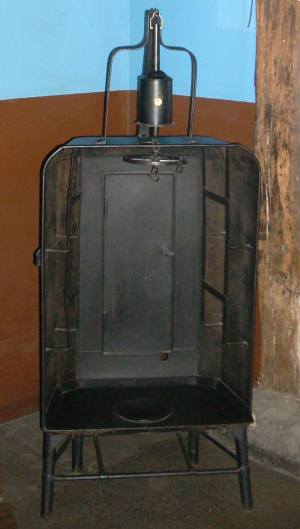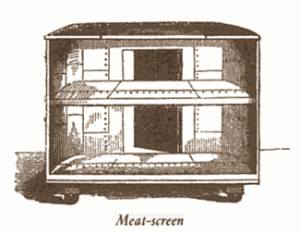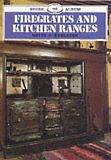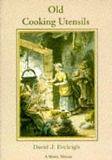-
History of:
- Resources about:
- More:
- Baby walkers
- Bakehouses
- Bed warmers
- Beer, ale mullers
- Besoms, broom-making
- Box, cabinet, and press beds
- Butter crocks, coolers
- Candle snuffers, tallow
- Clothes horses, airers
- Cooking on a peat fire
- Drying grounds
- Enamel cookware
- Fireplaces
- Irons for frills & ruffles
- Knitting sheaths, belts
- Laundry starch
- Log cabin beds
- Lye and chamber-lye
- Mangles
- Marseilles quilts
- Medieval beds
- Rag rugs
- Rushlights, dips & nips
- Straw mattresses
- Sugar cutters - nips & tongs
- Tablecloths
- Tinderboxes
- Washing bats and beetles
- Washing dollies
- List of all articles
Subscribe to RSS feed or get email updates.
A good meat-screen is a great saver of fuel. ...We have seen one, which had on the top of it a very convenient hot closet, which is a great acquisition in kitchens, where the dinner waits after it is dressed.
William Kitchiner, The Cook's Oracle, first published 1823
Firegrates and Kitchen Ranges by David Eveleigh, from Amazon.comor Amazon UK

Old Cooking Utensils by David Eveleigh, from Amazon.comor Amazon UK

Meat screens in front of the fire
Hasteners, hasters, roasters, screens, reflectors - aids to roasting
 This meat hastener
was used in front of an open fire to reflect heat back onto a joint of meat hanging
from the hook. The hook is joined on to a bottle jack
- a contraption which had to be wound up on a spring to make the joint twist from
side to side while roasting. The combination of bottle jack and meat hastener was
designed to get the meat evenly roasted without constant attention from the cook,
and to economise on fuel. Household manuals often say how important it is that the
inside should be well-polished - not black like this one - and often they are described
as lined with tin.
This meat hastener
was used in front of an open fire to reflect heat back onto a joint of meat hanging
from the hook. The hook is joined on to a bottle jack
- a contraption which had to be wound up on a spring to make the joint twist from
side to side while roasting. The combination of bottle jack and meat hastener was
designed to get the meat evenly roasted without constant attention from the cook,
and to economise on fuel. Household manuals often say how important it is that the
inside should be well-polished - not black like this one - and often they are described
as lined with tin.
The door at the back of the hastener allowed the cook to see how things were coming along, and reach in to baste the joint. There would have been a tray at the bottom to catch the dripping juices. The bottle jack was not essential. It was possible to use a horizontal spit with a different shape of screen. Isabella Beeton preferred to roast meat with a "common meat screen" like the one in the drawing below. She felt the "objection" to enclosed arrangements with a hook inside a three-sided hastener was that the meat ended up tasting like "baked meat".
Similar-looking "boxes" were sometimes called Dutch ovens. They weren't always used for roasting meat. Sometimes they had shelves to hold different dishes that could be cooked by the combination of direct heat from the flames and reflected heat from the metal back.
A bottle jack should always be used with a tin stand or case, called a hastener, movable, and standing on feet, with a dripping pan fixed in the bottom. This case is open to the fire in front, but closed at the back and sides. It should be of block tin, and should be kept very bright inside, that the rays of heat may be reflected back on the meat. Sometimes the hastener is made to serve also as a plate warmer.
IJ Kent, architect, On the Domestic Offices of a House, 1835
 The well-planned hastener/bottle-jack combination was a desirable new piece of kitchen
equipment in the 19th century. Like so many ingenious things that look hopelessly
old-fashioned to us, it was once an innovative idea for improving domestic life.
Simpler boxes on wheels like the early 19th century one in the drawing were also
used. Before that, shiny screens lined with tin, or sometimes brass, were in use
for fireside cooking, but not all rigged up with bottle jack, doors, drip tray etc.
The well-planned hastener/bottle-jack combination was a desirable new piece of kitchen
equipment in the 19th century. Like so many ingenious things that look hopelessly
old-fashioned to us, it was once an innovative idea for improving domestic life.
Simpler boxes on wheels like the early 19th century one in the drawing were also
used. Before that, shiny screens lined with tin, or sometimes brass, were in use
for fireside cooking, but not all rigged up with bottle jack, doors, drip tray etc.
The hastener seems to have been introduced in the 1800s, but meat screens were used before that. Meat screens are mentioned in household inventories and auction catalogues at least as far back as 1750, and simple reflective fireside screens were known before 1700. They were sometimes called roasters, but that could refer to other kinds of roasting/baking equipment too. Reflector or haster were other possible names.
Let the roaster or meat screen, basting ladle, and dripping pan be carefully dusted, and the spit or jack-hook, however clean when put away, have an additional rub. If the smallest particle of rust remains it will make a black mark in passing through the meat. If a spit is used it should be slid in along the bones, - if a hook, it should be so inserted as to take in a bone which will be a security against tearing the meat or suffering the juice to escape.
As to making up a fire nothing but practice and experience can make perfect.....at what time, and in what manner must I make up my fire so as to secure the desired result ? ...
The fire being properly made up, the meat screen had better be placed in front, both to draw up the fire, and to become itself thoroughly heated before the meat is put down. Reflected heat never dries or scorches meat, but greatly promotes its being thoroughly and hot done.
Esther Copley, The Housekeeper's Guide; or a Plain and Practical System of Domestic Cookery, first published 1834
More about simple roasting jacks and bottle jacks, or see this site about bottle jacks, spring jacks and spit jacks
 28 May 2009
28 May 2009
You may like our new sister site Home Things Past where you'll find articles about antiques, vintage kitchen stuff, crafts, and other things to do with home life in the past. There's space for comments and discussion too. Please do take a look and add your thoughts. (Comments don't appear instantly.)
For sources please refer to the books page, and/or the excerpts quoted on the pages of this website, and note that many links lead to museum sites. Feel free to ask if you're looking for a specific reference - feedback is always welcome anyway. Unfortunately, it's not possible to help you with queries about prices or valuation.




